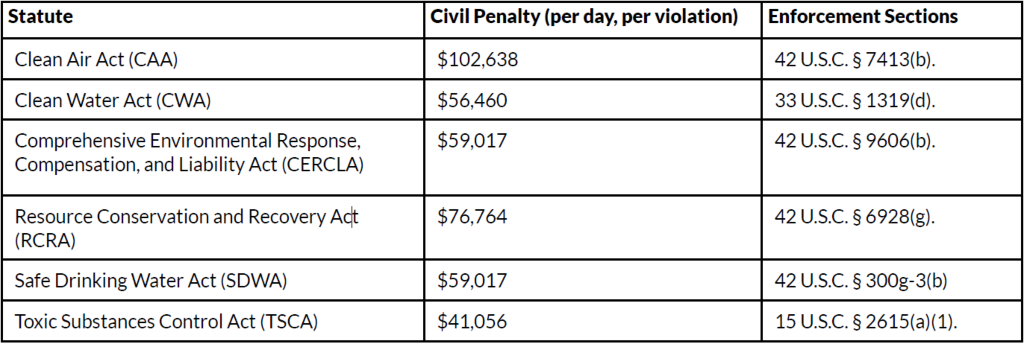News & Insights
Legal Alert

2021 Land Use, Environmental & Natural Resources Update
3.25.21
With the end of the first quarter of 2021 approaching, we thought it timely to issue an update on selected recent developments and proposed changes in law and policy touching environmental, land use, and natural resource issues. At the national level, with the new Biden administration, federal policies already have undergone a significant sea-change from those of the Trump administration. And the Golden State continues to lead with a protective agenda on land use, environmental, and natural resources legislation and regulation.
We present here a diverse set of selected snapshots on the federal and state of California policies, laws, regulations, and judicial opinions that have been adopted and issued in 2020 through the first quarter of this year on these topics of key concern to our clients. In the coming months, we look forward to offering more detailed accounts of new decisions and policies as they arise, including in our weekly newsletters – California Environmental Law & Policy Update, Renewable Energy Update, and Sustainable Development & Land Use Update. In the meantime, we hope you will find the below highlights to be of interest. Please reach out to anyone on our land use or environmental teams if you want to learn more or need help in navigating the various rules and regulations applicable to your projects or properties.
Land Use
New Year Bonus for Housing Developers
As of January 1, 2021, the maximum density bonus in California under the State Density Bonus Law (DBL) increased from 35% to 50% pursuant to AB 2345. To qualify for the new maximum bonus, at least 15% of the residential units must be set aside for very low-income households, 24% of the units for lower-income households, or 44% of the (common interest) units for moderate-income households, as each is defined in the DBL.
AB 2345 also lowered the threshold for so-called development “concessions and incentives” under the DBL (e.g., modifications of local zoning requirements and reductions in site development standards), and reduced required off-street parking for qualifying projects.
See our December legal alert and webinar for more information about the DBL and AB 2345, in addition to a recent article in the Daily Journal authored by Caroline Chase, a Land Use Partner in our San Francisco office.
Contact Caroline Chase
New California Rules Concerning ADUs
In an effort to combat the ongoing housing crisis, the California State Legislature has in recent years passed several laws, including AB 3182 this past legislative session, that restrict how municipalities and common interest developments can and cannot regulate accessory dwelling units (ADUs). As a response, several cities throughout the state have enacted programs to help streamline the ADU permit review process, as summarized below.
AB 3182
Effective January 1, 2021, AB 3182 limits how common interest developments (CIDs) can restrict homeowners from renting out their dwelling units (including both ADU and main house leases). Under AB 3182, CIDs can ban short-term rentals that are less than 30 days but cannot impose rental restrictions that limit the renting or leasing of any dwelling unit to less than 25% of the total number of separate interests within the CID. ADUs are not considered separate interests. Separate interests are also not considered “occupied” by a renter if either the separate interest or its ADU is occupied by the owner. Thus, ADUs cannot be counted towards a CID’s rental restriction cap tally.
CIDs that “willfully” violate AB 3182 will be liable to a fine up to $1,000 and must pay actual damages incurred by the applicant.
AB 3182 also clarifies that if a municipality has not acted upon a completed ADU application within 60 days, the application will be deemed approved.
San Francisco
The City and County of San Francisco recently established an online portal for submitting ADU applications. The website also provides an ADU application checklist and screening form as well as an ADU Fact Sheet (which broadly summarizes state legislation for single-family and multi-family ADUs).
San Diego
The City of San Diego created an ADU building permit information bulletin (which provides an overview on the City’s ADU application process). The City’s website also lets applicants schedule free virtual planning and zoning appointments where staff can answer questions about the ADU entitlement procedure. All new ADU permit applications must be submitted electronically.
Los Angeles
The City of Los Angeles accepts ADU applications either electronically or at any of its Development Service Center locations. The Department of Building and Safety website now also summarizes the City’s ADU entitlement process.
The City recently established an innovative ADU Accelerator Program, which matches prospective ADU tenants over the age of 60 with homeowners. The City screens tenants through an application process to ensure that they can afford the ADU’s monthly rent. To qualify, homeowners must own residential property in the City and have a legally permitted existing ADU with a Certificate of Occupancy (or be in the process of receiving a Certificate of Occupancy). Under the program, homeowners currently receive the following fixed monthly rental payments for their units:
- Studio ADU — $1,369
- One-bedroom ADU — $1,765
- Two-bedroom ADU — $2,263
- Three-bedroom ADU — $2,735
Qualifying tenants must pay 30% of their income towards rent; the remainder is subsidized by the City.
City of Los Angeles Considers Comprehensive Sign Regulation Update
In December 2020, Los Angeles City Planning introduced new revisions to the City’s sign regulations. This update is 11 years in the making as the City has considered some form of changes to sign regulations as far back as 2009. Although previous attempts to revamp regulations have been ineffective, momentum surrounding the subject is expected to result in some form of an amendment to existing regulations.
On February 25, 2021, the City Planning Commission considered and rejected a large majority of the comprehensive changes that were developed over the last year. The City Planning Commission instead supported an update that was originally introduced in 2015.
Highlights from that version of the proposed sign ordinance update include:
- A Two-Tier Sign District System – Under the proposed legislation, any new sign district would fall into one of two tiers. Tier 1 Sign Districts are contemplated for large regional centers and entertainment districts. Tier 2 Sign Districts are envisioned for smaller, campus-like settings where off-site signage would be permitted if not visible from another property or public right of way.
- Reduction Requirements – The proposed legislation would require reduction of existing off-site signs when adding new signs in Tier 1 Sign Districts. The draft legislation approved by the City Planning Commission would require a reduction of five square feet of existing off-site static signage for every one square foot of new off-site static signage. This ratio would be 10:1 for off-site digital signs in Tier 1 Sign Districts.
- Digital Displays – Existing signage regulations are silent regarding off-site digital display sign standards. Under the draft legislation approved by the City Planning Commission, digital displays on any sign type, would only be permitted within a sign district, subject to illumination, display, and operating hour requirements.
The next step for the proposed legislation will be consideration by the City Council. The proposed legislation would need to be adopted by a simple majority vote of the full City Council before signature by the Mayor.
Contact Amarveer Brar
Golden Door Properties Case Potentially Expands the Scope of Discovery in CEQA Cases
Developers and agencies concerned about the costs of California Environmental Quality Act (CEQA) litigation, including related project delays, should take note of Golden Door Properties v. Superior Court (2020) 52 Cal.App.5th 837. In this case, the court held that a lead agency violated CEQA's requirements for the preservation of the challenged project's administrative record by routinely deleting emails after 60 days. Two of the court's ancillary holdings are particularly significant from a litigation time and cost standpoint:
- Under CEQA (Sections 21000 et seq of the Public Resources Code), the administrative record upon judicial review must broadly include all of the lead agency's internal and external emails (and potentially even all internal notes and other non-electronic documentation) relating to the project or the agency's CEQA compliance for the project. (CEQA § 21167.6(e).) This holding reaffirms the principle that the administrative record must include "pretty much everything that ever came near a proposed development or to the agency's compliance with CEQA in responding to that development." (citing Madera Oversight Coalition, Inc. v. County of Madera (2011) 199 Cal.App.4th 48, 64).
- A CEQA petitioner may utilize the Civil Discovery Act (Code Civil Procedure, §§ 2016.010-2036.050) to propound discovery upon the lead agency, responsible agencies, the developer, and even project consultants in order to obtain documents that rightfully fall within the scope of the administrative record under CEQA Section 21167.6(e).
CEQA petitioners will inevitably cite Golden Door Properties in efforts to expand the scope of the administrative record and to seek discovery of emails and other documents, including documents in possession of developers and project consultants. This case could indicate that discovery battles may become more common place in CEQA litigation.
Certain Housing Project Modifications Exempt from CEQA Under AB 831
AB 831, an urgency statute that took effect on September 28, 2020, strengthened SB 35, the 2017 statute that allows certain qualified housing projects and housing-rich, mixed-use projects that meet a long list of requirements to be processed as ministerial projects exempt from CEQA. Because housing developments frequently need to evolve after entitlements are approved, AB 831 allows a developer to make certain qualifying minor modifications to an SB 35-approved project prior to the issuance of the final building permit, so long as the modified project continues to meet specified objective standards that were in place when the original application was submitted to the local jurisdiction.
AB 831 also provides that for SB 35-approved projects that require off-site public improvements, an agency shall not delay or exercise its discretion over the off-site improvements in a manner that would inhibit, chill, or preclude the development. Together, these modifications help ensure that cities do not sidestep the intent of SB 35's ministerial approval process through post-approval review.
AB 1561 Extends Housing Entitlement Deadlines
AB 1561, a statute that took effect on September 28, 2020, provides relief to the housing industry in light of the coronavirus pandemic. It extends by 18 months the period for the expiration, effectuation, or utilization of a “housing entitlement” that was issued before and was in effect on March 4, 2020, and that will otherwise expire before December 31, 2021. Significantly, the section broadly defines “housing entitlement” as including not just subdivision maps, but all manner of discretionary and ministerial approvals issued by state or local agencies needed to develop housing developments. The definition does explicitly exclude development agreements, SB-330 preliminary applications, and applications for an SB 35 permit. Cities and counties may still independently grant additional entitlement extensions.
City of Coronado v. SANDAG: San Diego Superior Court Upholds Major Shift in Regional Power During RHNA Process
City of Coronado et al. v. SANDAG et al., San Diego Superior Court, Case No. 37-2020-0033974, was filed by four small cities in San Diego County against the Board of Directors for the San Diego Association of Governments (SANDAG) to challenge SANDAG’s allocation of housing under the State Housing Element Law. The trial court recently issued a minute order granting SANDAG’s demurrer in what appears to be an early victory for pro-housing forces.
As background, State Housing Element Law (Govt. Code § 65580 et seq.) requires that every local jurisdiction adopt a housing element as a part of its General Plan and update that element every five or eight years, depending on where the jurisdiction is located. The housing element must contain “a quantification of the locality’s existing and projected housing needs for all income levels, including extremely low income households,” to satisfy “the locality’s share of the regional housing need.” (Govt. Code § 65583(a)(1).) The Department of Housing and Community Development (HCD) quantifies existing and projected regional housing needs for each region of California through the Regional Housing Needs Assessment (RHNA) process. Regional councils of government, like SANDAG, then “adopt a final regional housing need plan that allocates a share of the regional housing need to each city, county, or city and county.” (Govt. Code § 65584.) Each council of governments develops its own allocation methodology, to be approved by HCD.
In 2017, Assemblywoman Lorena Gonzalez introduced AB 805, which revised the weighted vote process for decisions made by SANDAG. Previously, decisions were made by both a simple tally of board members’ votes and by a vote weighted according to the population of each member government. AB 805 altered this process to allow the weighted vote to override the tally vote. This change dramatically shifted power to larger, more-populated jurisdictions and away from smaller jurisdictions, the latter of which previously could join forces to reject items the smaller agencies disliked.
In 2020, the Cities of Coronado, Solana Beach, Imperial Beach, and Lemon Grove (Petitioners) objected to SANDAG’s latest housing allocation. The SANDAG Board of Directors rejected the agencies’ administrative appeals by another weighted vote. The cities then filed a petition for writ of mandate to the San Diego Superior Court seeking, among other things, invalidation of SANDAG’s RHNA allocation and a prohibition on the weighted vote procedure. The petition argued that SANDAG committed a prejudicial abuse of discretion by using the weighted vote procedure in the quasi-judicial appeal hearing, as well as bias on the part of SANDAG’s Board of Directors.
On February 5, 2021, the court issued a minute order granting SANDAG’s demurrer based on City of Irvine v. Southern California Association of Governments (2009) 75 Cal.App.4th 506. In City of Irvine, the appellate court held that a local government’s RHNA allocation is exclusively subject to administrative, as opposed to judicial, review. The San Diego Superior Court cited City of Irvine and determined that the Legislature specifically eliminated judicial review of RHNA allocations by removing authorization for such judicial review when it amended former Government Code section 65584 in 2004. The court did not grant leave to amend the petition.
The trial court’s minute order in the City of Coronado case upholds a massive shift in power during the housing allocation process from local governments to regional councils of government. The consequences of this decision likely will echo throughout the state as the ongoing housing crisis continues unabated.
Contact Heather S. Riley, E. Bo Peterson, Rebecca Williams
SB 7 Would Reenact and Extend the Scope of the Jobs and Economic Improvement Through Environmental Leadership Act
California SB 7 would reenact the Jobs and Economic Improvement through Environmental Leadership Act of 2011 (the Leadership Act), a law that allowed certain major development projects, certified by the Governor as Environmental Leadership Development Projects (ELDPs), to take advantage of streamlining provisions and expedited legal challenges under the California Environmental Quality Act (CEQA). The Leadership Act expired on January 1, 2021. SB 7 would reestablish and update certain provisions of the Leadership Act and extend its effective date until January 1, 2026.
Updates to the Leadership Act under SB 7 would include:
- Expanded ELDP eligibility to include smaller housing development projects, with affordable housing components, located on infill sites;
- Specific standards for quantifying and measuring greenhouse gas emissions from ELDPs;
- Additional construction labor requirements added to existing prevailing wage and project labor agreement requirements; and
- Specific language that states any court challenge to an ELDP approval, including potential appeals to the court of appeal or California Supreme Court, must be resolved within 270 days.
SB 7 represents a second effort to renew the Leadership Act. It picks up where SB 995, a similar bill that failed in 2020, left off.
Contact Spencer B. Kallick, Amarveer Brar
Warehouse Regulation
Proposed Southern California Rule Would Require Industrial Warehouses to Mitigate Truck Emissions
On May 7, the South Coast Air Quality Management District, which regulates air emissions in certain parts of Southern California, will consider a proposal that might create a significant cost burden to owners and operators of industrial warehouses. If adopted, it would require them to collect and calculate truck data annually. Warehouse owners and operators will need to earn WAIRE (Warehouse Actions and Investments to Reduce Emissions) points through installing infrastructure supporting zero-emission trucks and installing solar panels on buildings. The proposal uses a broad definition of warehouse space, applying it to structures with at least 100,000 square feet of indoor floor space. Meeting these requirements may be difficult for some owner-operators. See our recent alert on this topic.
Contact Dana P. Palmer
Vapor Intrusion
Statewide Draft Guidance for Vapor Intrusion Analysis Will Likely Be Adopted – in One Form or the Other – in 2021
In February 2020, the California Environmental Protection Agency and two of its constituent agencies, the Department of Toxic Substances Control and the State Water Resources Control Board, working with the San Francisco Bay Regional Water Quality Control Board, jointly issued their “Supplemental Guidance: Screening and Evaluated Vapor Intrusion” (Supplemental Guidance) for public review and comment. The agencies, which received 575 comments on the draft, have announced that they expect to issue a final version of the Supplemental Guidance in the Spring of 2021.
The Supplemental Guidance describes a four-step process for evaluating and addressing human health risks caused by vapor intrusion (VI), i.e., the passage of vapor-forming chemicals (VFCs) in soils into overlying buildings. The Supplemental Guidance applies to VI due to all kinds of VFCs – mainly volatile organic compounds – except for VI due to petroleum from underground fuel storage tanks, which is to be evaluated using the State Water Resource Control Board’s 2012 Low Threat Closure Policy.
The four steps are these:
- Selection of existing buildings for VI assessment based on their proximity to sources of VFCs in soil and groundwater and the existence of physical conduits, including sewer facilities, through which soil vapors could make their way into the interior.
- Soil vapor sampling around buildings selected for assessment, or within or near the footprint of planned future buildings, and estimation, for screening purposes, of the risk of VI using “attenuation factors,” i.e., the proportion of soil vapor that is to be assumed to pass into the overlying building.
- For existing buildings that are not screened out in step two, implementation of a program of indoor air, outdoor air, and sub-slab soil vapor sampling.
- Evaluation of the sampling data to assess the current and future vapor intrusion risk, and identification, if necessary, of cleanup and/or mitigation measures to reduce the risk to acceptable levels.
The Supplemental Guidance provides varying levels of detail in its instructions and recommendations for each of these steps, and includes separate, in-depth discussions of VI assessment considerations for large buildings, particularly those with multiple floors, multiple tenants, and multi-zone heating, ventilation, and air conditioning (HVAC) systems, and buildings with crawl spaces and/or below- or at-grade parking garages.
Among the controversial features of this four-step process is the mandate, in the second step screening, to apply fixed attenuation factors published by the U.S. Environmental Protection Agency (EPA) in 2015, at all sites and buildings, in lieu of modeled site-specific attenuation factors that agencies had previously accepted. These fixed attenuation factors are quite conservative – they assume, for example, that 3% of all external soil vapors work their way into buildings – and thus trigger requirements for expensive and disruptive indoor and sub-slab vapor sampling in a large number of buildings. The sponsoring agencies acknowledge in the Supplemental Guidance that EPA’s attenuation factors are based on data collected mainly outside California, and, for this reason, the agencies announce in the Supplemental Guidance that they will be collecting data aimed at generating California-specific attenuation factors within the next couple of years. In the meantime, unless the Supplemental Guidance is revised in response to comments, responsible parties are left with the inflexible EPA attenuation factors.
Other controversial features of the four-step process are the heavy focus in the first step on evaluation of potential sewer conduits, and the requirements in steps two and three for two, or even three, rounds of soil vapor and/or indoor air sampling, to be conducted in different seasons (and hence separated in time by months), before a building can be screened out as a low risk for vapor intrusion. These and other elements of the Supplemental Guidance have been challenged in a number of the formal comments submitted in response to the Draft.
Contact David D. Cooke
Federal Penalties
Annual Federal Penalty Adjustments Published for Major Environmental Statutes
Pursuant to the Federal Civil Penalties Inflation Adjustment Act, the U. S. Environmental Protection Agency (EPA) recently published adjusted maximum civil penalties applicable to major environmental statutes, increasing the total maximum daily penalty per violation, as follows:

The adjusted amounts will apply to civil monetary penalties assessed after December 23, 2020, for violations that occurred after November 2, 2015. (40 C.F.R. § 19.4).
Climate Change and Renewable Energy
Biden Executive Orders Support Goal of Net-Zero Emissions by 2050
During his campaign, President Biden articulated a “Plan for a Clean Energy Revolution and Environmental Justice,” (Clean Energy Plan) outlining ambitious goals to achieve 100% clean energy economy and net-zero emissions by 2050. The Plan outlined target areas to meet the net-zero emissions goal, including:
- Reducing greenhouse gas (GHG) emissions from transportation by developing rigorous new fuel economy standards and restoring the electric vehicle tax credit along with deployment of half a million new public charging outlets by the end of 2030;
- Requiring all federal permitting decisions to consider GHG effects on climate change;
- Requiring public companies to disclose GHG emissions in their operations and supply chains as well as climate risk; and
- Incentivizing biofuels to reduce aircraft and vessel emissions.
The Plan also committed to reducing by 50% the carbon footprint of the U.S. building stock by 2035, creating incentives for deep retrofits that combine appliance electrification, efficiency, and on-site power generation.
Notably, the Plan also promised to reinstate federal environmental protection measures rolled-back by the Trump administration; and it highlighted the intent to achieve a “clean economy revolution” benefitting low-income communities and communities of color historically hardest-hit by pollution. In his first days in office, President Biden signed a series of executive orders that support the implementation of his Clean Energy Plan. We summarize these orders below, but note that all are available in the White House virtual briefing room:
- Center the Climate Crisis in U.S. Foreign Policy and National Security Considerations—the order rejoins the United States to the Paris Agreement and establishes objectives of short-term and long-term emissions reductions to achieve net zero global emissions by 2050;
- Leverage the Federal Government’s Footprint and Buying Power to Lead by Example—the order seeks to identify steps to double renewable energy production from offshore wind by 2030 and directs federal agencies to procure carbon pollution-free electricity and clean, zero emission vehicles to stimulate the clean energy industry;
- Rebuild Our Infrastructure for a Sustainable Economy—the order takes steps to accelerate clean energy and transmission projects under federal siting and permitting processes in an environmentally sustainable manner and catalyzes the creation of jobs in construction, manufacturing, and engineering;
- Revitalizing Energy Communities—the order creates an interagency working group on Coal and Power Plant Communities and Economic Revitalization directed to explore efforts to turn idled properties (including brownfields) into new hubs for economic growth for communities impacted by coal, oil, and power plant shut-downs;
- Secure Environmental Justice and Spur Economic Opportunity—the order creates a government-wide “Justice40” initiative with the goal of delivering 40% of the overall benefits from relevant federal investments to disadvantaged communities;
- Take a Whole-of Government Approach to the Climate Crisis—the order creates a central office in the White House charged with coordinating and implementing the President’s climate agenda; and
- Protecting Public Health and Environment and Restoring Science to Tackle the Climate Crisis—the order requires all federal agencies to immediately review all regulations, orders, policies, and actions taken under the Trump Administration with the purpose of rescinding anti-environmental rules and policies.
To fully implement this agenda, President Biden will need to work extensively with Congress to enact new legislation.
California Proposed Legislation Sets Planning Targets for Offshore Wind and Eases Permitting for Solar and Energy Storage
As California continues to grow its renewable energy capabilities, documented weekly in our Renewable Energy Update, State Assemblyman David Chiu, D-San Francisco, has introduced legislation that would require state regulators to set a planning target of at least 10 gigawatts of offshore wind production by 2040, with a short-term goal of 3 GW by 2030. The legislation, AB 525, also directs state agencies to begin securing necessary federal permits and planning for port upgrades and other infrastructure projects.
State Senator Scott Wiener, D-San Francisco, has introduced SB 617, the Solar Access Act, which would implement automated solar permitting in local California jurisdictions with more than 10,000 residents. SB 617 will allow for remote inspections and approvals of residential solar and combination solar and energy storage systems. The bill is projected to greatly decrease approval times, cut permitting costs for local governments and homeowners, and help California meet its greenhouse gas emission reduction goals.
Contact Dana P. Palmer
Water Quality
EPA Issues Final Guidance On When A Clean Water Act NPDES Permit Is Required For Discharges Into Groundwater
In a precedent-setting decision in April 2020, the U.S. Supreme Court, in County of Maui v. Hawaii Wildlife Fund, 140 S. Ct. 1462 (2020) (Maui) ruled that a discharge of pollutants into groundwater from a point source could require a National Pollution Discharge Elimination System (NPDES) permit for discharges into “waters of the United States” (WOTUS) if the discharge is the “functional equivalent of a direct discharge from the point source into navigable waters.”
The Supreme Court articulated a non-exhaustive seven-factor test to determine “functional equivalency,” including consideration of:
- transit time;
- distance traveled;
- the nature of the material through which the pollutant travels;
- the extent to which the pollutant is diluted or chemically changed as it travels;
- the amount of pollutant entering the navigable waters relative to the amount of the pollutant that leaves the point source;
- the manner by or area in which the pollutant enters the navigable waters; and
- the degree to which the pollution (at that point) has maintained its specific identity.
On January 14, 2021, one week before the new Biden administration would take office, the U.S. Environmental Protection Agency (EPA) issued its final regulatory guidance entitled Applying the Supreme Court’s County of Maui v. Hawaii Wildlife Fund Decision in the Clean Water Act Section 402 National Pollution Discharge Elimination System Permit Program (Final Guidance) to implement, and narrow, the practical effect of the Maui decision. It did so by articulating an eighth factor—in addition to the seven factors articulated in Maui—to be considered in determining “functional equivalency” – the design and performance of the system or facility from which the pollutant is released.
In its Final Guidance, the EPA reasoned that the design and performance of the system or facility is an important factor routinely considered by the agencies administering the NPDES permit program. The EPA Final Guidance explains that the eighth factor should be considered because a system by design may, for example, promote dilution, absorption, or dispersion of the pollutants through chemical or biological interaction with soils, microbes, plants and their root zone, or simply through physical attenuation which could chemically change or diminish the amount of pollutants entering WOTUS compared to the pollutant composition and concentration leaving the point source. If that occurs, according to the EPA, the discharge via groundwater is no longer likely to be “functionally equivalent” to a direct discharge to WOTUS due to the intervening change in the composition or concentration of pollutants initially discharged. Thus, consideration of the design and performance of the system or facility could provide a more flexible, lenient approach that would allow discharges to groundwater without any NPDES permit, even if they ultimately reach WOTUS.
Notably, the EPA’s Final Guidance highlights the fact that there must be an actual point source discharge, rather than just a potential discharge, and that ultimately not all point source discharges to groundwater reaching WOTUS will be the functional equivalent of a direct discharge. It also notes that, historically, very few permits have been issued for point source discharges that reach WOTUS via groundwater, and it is expected that the issuance of such permits will remain minimal in the future.
It is widely anticipated that the Biden administration will rescind the Final Guidance, particularly in light of the executive order signed the afternoon of the inauguration requiring all agencies, including the EPA, to immediately review existing regulations, guidance documents, and orders adopted during the Trump administration which may be inconsistent with the environmental policies of the incoming administration. We may also see further rulemaking to clarify the factors to be considered when determining the extent to which point source discharges to WOTUS via groundwater will require an NPDES permit. In the meanwhile, over the course of the next year or years, we expect more guidance will come in the form of judicial interpretation and application of the Maui decision, which will continue to inform decision-making as to when a permit for discharges to groundwater will be required. For now, it would be prudent for facilities that discharge to groundwater to evaluate those discharges in light of at least the seven Maui “functional equivalency” factors to assess whether a Clean Water Act permit is now required.
Contact Sandi L. Nichols
Biden Administration to Take Its Turn at Clarifying the Muddied Meaning of “Waters of the United States”
The statutory phrase “waters of the United States” (WOTUS)—“a key component of the Clean Water Act (CWA)—has been the subject of ongoing debate for nearly five decades. Yet the meaning of the phrase, which the Act does not define, remains elusive and unpredictable.” State of Colorado v. U.S. Environmental Protection Agency, 2021 U.S. App. LEXIS 6070 (10th Cir. March 2, 2021).
As a consequence, the regulated community—developers, operators of industrial facilities and wastewater treatment plants, farmers and ranchers, among others—has been in a perpetual state of uncertainty, given that each must decipher the scope of WOTUS in order to secure any required CWA permits to develop, dredge, fill, discharge into, or cultivate areas with jurisdictional waters, including wetlands, certain tributaries, and potentially groundwater too. (See above regarding January 2021 EPA guidance addressing the U.S. Supreme Court’s 2020 decision in Maui.)
By way of background, in Rapanos v. United States, 547 U.S. 715 (2006), the U.S. Supreme Court itself was conflicted, in a 4-1-4 decision, in which Justice Scalia, writing for a four-Justice plurality, limited the scope of WOTUS to include only those “relatively permanent, standing or continuous flowing bodies of water,” noting that this does not include channels through which water flows intermittently or ephemerally, or channels that periodically provide drainage for rainfall.” (Id. at 739). Justice Kennedy, while concurring in the plurality opinion, independently opined that WOTUS should include those waters that have a “significant nexus” to navigable waters, a standard since adopted by most courts as the controlling precedent.
Since Rapanos, in 2015 and again in 2020, under the Obama and Trump administrations, respectively, the definition of WOTUS has been modified by regulations promulgated by the U.S. Environmental Protection Agency (EPA) and the U.S. Army Corps of Engineers (Corps)—the federal agencies charged with responsibility for implementing the CWA. Now, it is likely the Biden administration too will take its turn at redefining WOTUS.
In 2015, the Obama administration issued rulemaking purporting to codify Justice Kennedy’s “significant nexus” test. (See 80 Fed. Reg. 37,054 (June 29, 2015) (2015 Rule).) The 2015 Rule effectively expanded the scope of jurisdictional waters, to include ephemeral streams (tributaries that have physical signs of flowing water, even if they run for only part of the year) and regional water features, such as prairie potholes and coastal bays. Following numerous lawsuits, the 2015 Rule ultimately was effective in fewer than half the states, and in the 28 other states, prior EPA/Corps regulations from the 1980s controlled.
In June 2020, the Trump administration repealed and replaced the 2015 Rule with the “Navigable Waters Protection Rule” (NWPR), effectively excluding from the definition of WOTUS 12 categories of waters, including groundwater, ephemeral streams, and features that flow only in direct response to precipitation, prior converted crop land, artificially irrigated areas that would revert to upland if artificial irrigation ceases, and wetlands physically separated from jurisdictional waters by upland or by dikes or similar structures and which also lack a direct hydrologic surface connection to jurisdictional waters. Various courts rejected efforts by at least 17 states to prevent the NWPR from taking effect in their states, except for a district court in Colorado. And, on March 2, 2021, the 10th Circuit denied a requested stay of the appeal and, on March 4, overturned the preliminary injunction granted by the district court in Colorado. The NWPR therefore—at least at the time of this publication—provides the currently-effective definition of WOTUS under the CWA.
We expect the Biden administration will repeal the NWPR and issue its own rule to more closely track the 2015 Rule. Already, the Biden administration has requested stays in pending litigation on the issue, citing its recent Executive Order calling on all federal agencies to review and rescind rules and regulations passed under the Trump administration which are inconsistent with the incoming administration’s goals of promoting environmental protection—presumably including the NWPR. At least four district courts have granted stays to permit the Biden administration time to review the rule.
In late February, the Biden administration withdrew its appeal (taken by the Trump administration) of a Northern District of California court ruling that held that salt ponds in San Francisco Bay that are no longer in productive use and are asserted to be “fast lands” were still jurisdictional waters (S.F. Baykeeper v. United States EPA, 2020 U.S. Dist. LEXIS 184275 (N.D. Cal. 2020)), signaling the administration’s likely rejection of the NWPR and its anticipated move to adopt a more expansive interpretation of WOTUS.
In addition, Michael Regan, President Biden's newly confirmed EPA administrator, during his confirmation hearing in February, opined that the NWPR rollback went too far, leaving vulnerable wetlands unprotected, and said that, if confirmed, he plans to ensure that any final WOTUS regulation is clear and understandable, but not overly burdensome. Regan testified that he ultimately wants a rule that gives states the flexibility to protect water quality and local agricultural economies.
We expect the Biden administration to move quickly to initiate rulemaking in order to prevent the issue from playing out in court, and potentially being decided by the conservative Supreme Court majority, which is more likely to favor the narrower interpretation of WOTUS as defined in Justice Scalia’s plurality opinion in Rapanos.
Contact Sandi L. Nichols
California Wineries Required to Comply with New Water Discharge Permit
On January 20, 2021, the California State Water Resources Control Board (State Water Board) adopted a new statewide general Waste Discharge Requirement (WDR) order for winery process waste discharge facilities (New Winery Order). This action will affect thousands of wineries and wine processing facilities throughout the state. Though the State Water Board adopted the New Winery Order to streamline and improve permitting consistency while also strengthening environmental protection, wine industry groups have expressed concerns over its burdensome compliance costs that will further harm an industry already facing significant challenges from the COVID-19 pandemic and wildfires.
While it exempts wine facilities that produce less than 10,000 gallons per year of waste process, the New Winery Order applies statewide and establishes four tiers of discharges based on annual quantities; each tier has different discharge specifications and monitoring requirements (larger facilities are subject to stricter regulations). The New Winery Order lets Regional Water Quality Control Boards require Tier 3 and 4 facilities to prepare costly site-specific nitrogen control plans. Existing wineries (except those with an existing individual WDR, coverage under an existing general WDR, or “conditional waivers” of a WDR) must seek coverage under the New Winery Order. Wineries operating under existing WDRs or conditional waivers of a WDR can continue to discharge under that authority until those orders expire or come up for renewal. Facilities seeking coverage have until January 20, 2024, to file a Notice of Intent to comply with the New Winery Order. They then have five years after submitting their Notice of Intent to comply with the New Winery Order.
As of March 9, 2021, the State Water Board has yet to post the final approved version of the New Winery Order. As such, this analysis covers the draft final New Winery Order that the State Water Board released on December 2, 2020.
State Water Board’s staff will host three public virtual workshops on the following dates to discuss the New Winery Order’s enrollment eligibility, compliance timelines, and an overview of its requirements. The workshops will occur on the following dates:
- Thursday, April 8, 5:30-7:00 PM;
- Wednesday, April 21, 12:00-1:30 PM; and
- Friday, April 23, 12:00-1:30 PM.
Contact Barry H. Epstein
Water Supply
California Water Futures Available for Trading
To much ado, California water futures began trading in December 2020 on the Chicago Mercantile Exchange, a development causing many to compare water to other commodities subject to futures trading, like gold or oil, and causing much hand wringing about moving water, a necessity and basic human right, based on price change contracts. Although in the West, the popular adage about water is grounded in historical truth, “Water flows uphill towards money.”
It is highly unlikely that the new ability to invest in futures contracts tied to California water prices will have any significant impact on future water accessibility, utilization, transfers or prices. The pricing data driving the outcome of futures contracts is from a small slice of select transactions involving a rather modest number of participants and impacting a tiny percentage of the massive volume of water utilized in California. And even more fundamentally, the new water futures contracts are not real commodity contracts. No water supply or water supply transaction is tied to the outcome of any futures contract.
Unlike a commodity contract where a real commodity moves when a price threshold occurs, no water will move in response to changes in future water prices. Rather, the water futures contract is a sportsbook type of bet, although not a bet with the house, only a bet with some investor willing to take the other side. When future prices occur, someone will win money or lose money based on what they bet would occur. It is as simple as that.
However, elsewhere in the West, many are investing in water by purchasing and controlling farmland with historical water rights that may later be marketed to those willing to pay more. This development may eventually lead to significant impacts on who, where, and at what cost water is available for new development and growth.
Contact David L. Osias
California Groundwater Regulatory Issues to Look Out for in 2021
Californians use a lot of groundwater. In an average year, underground aquifers provide approximately 40% of the state’s water. In dry years, the percentage can increase to 60% or more. Given the importance of this resource to the economy, agricultural production, and rural and urban development across the state, highlighted below are three key groundwater issues for 2021 with broad legal, regulatory, and practical impacts ranging from the regional to the local.
The Western Water Crisis Continues
Despite several seasons of above-average precipitation that helped build snow pack, fill reservoirs, and replenish aquifers, drought conditions have once again returned to large portions of the western United States. As of late January 2021, approximately 65% of the western United States was experiencing severe drought conditions, or worse, compared with 5% of the region just one year prior. In California alone, approximately 30.4% of the state’s 39.5 million residents live in drought-impacted areas. These persistent drought conditions coupled with years of population growth across the West have put the region on a collision course with difficult water management decisions. In California, as groundwater supplies remain limited, conflicts over groundwater extraction, the allocation and priority of water rights, and water-management decisions will, absent a drastic change in the region’s hydrologic fortunes, continue in the coming months and years.
Litigation Looms as Implementation of the Sustainable Groundwater Management Act Gathers Pace
In 2014, California Governor Jerry Brown signed into law a package of legislation, the Sustainable Groundwater Management Act (SGMA), that marked California’s first attempt to develop a comprehensive statewide approach to managing groundwater. SGMA established a new framework for groundwater management centered around locally-controlled groundwater sustainability agencies (GSAs) tasked with developing and implementing over a 20-year time horizon groundwater sustainability plans for the groundwater basins deemed most imperiled by the state. In January 2020, GSAs of critically over-drafted basins submitted to state regulators, and began implementing at the local level, sustainability plans. Plans for the remaining basins covered by SGMA are in development and will be submitted in January 2022.
However, as the Act enters its seventh year of implementation, several key unaddressed issues loom on the horizon. Chief among these is the reality that while SGMA specifies that it neither “determines [nor] alters . . . groundwater rights,” GSAs are granted broad management powers to bring regulated basins into compliance with sustainability plans, including the ability to limit groundwater extractions and establish extraction allocations. SGMA, however, offers no guidance on how SGAs are to allocate remaining groundwater rights. Ultimately, in basins where a conflicts exists over the allocation method and the priority of rights, litigation and an adjudicated basin may follow.
This and several other thorny issues related to the Act’s implementation are likely to be subject to cases of first impression in 2021 and beyond. Indeed, the litigation has commenced and lawsuits challenging sustainability plans submitted by the January 2020 deadline have already been filed. The resolution of these and future cases promises to refine and potentially reshape the Act’s implementation, fundamentally changing statewide groundwater management in the process.
Environmental Review May be Required for Groundwater Well Construction Permits
Finally, at the local level, the California Supreme Court, in Protecting Our Water and Environmental Resources v. County of Stanislaus (2020) 10 Cal. 5th 479, 499-501, recently determined the California Environmental Quality Act may apply to well-construction permits, depending on a case-by-case evaluation of local standards applicable to a permits’ issuance. This ruling marks a significant departure from the practice in many counties of classifying categories of permits, such as well-construction permits, as ministerial. While the broader impacts of the court’s holding on other categories of ministerial land use permits remains to be seen, in the groundwater context, applicants for well-construction permits may be subject to new delays, expenditures, and legal challenges before obtaining approvals that in the past were classified as ministerial.
Contact Eoin D. McCarron
Authors
Associate
Partner
Partner
Partner
Associate
Partner
Partner
Partner
Partner
Senior Counsel
Associate
Partner
Associate
RELATED SERVICES
News & Insights
Allen Matkins Leck Gamble Mallory & Natsis LLP. All Rights Reserved.
This publication is made available by Allen Matkins Leck Gamble Mallory & Natsis LLP for educational purposes only to convey general information and a general understanding of the law, not to provide specific legal advice. By using this website you acknowledge there is no attorney client relationship between you and Allen Matkins Leck Gamble Mallory & Natsis LLP. This publication should not be used as a substitute for competent legal advice from a licensed professional attorney applied to your circumstances. Attorney advertising. Prior results do not guarantee a similar outcome. Full Disclaimer













